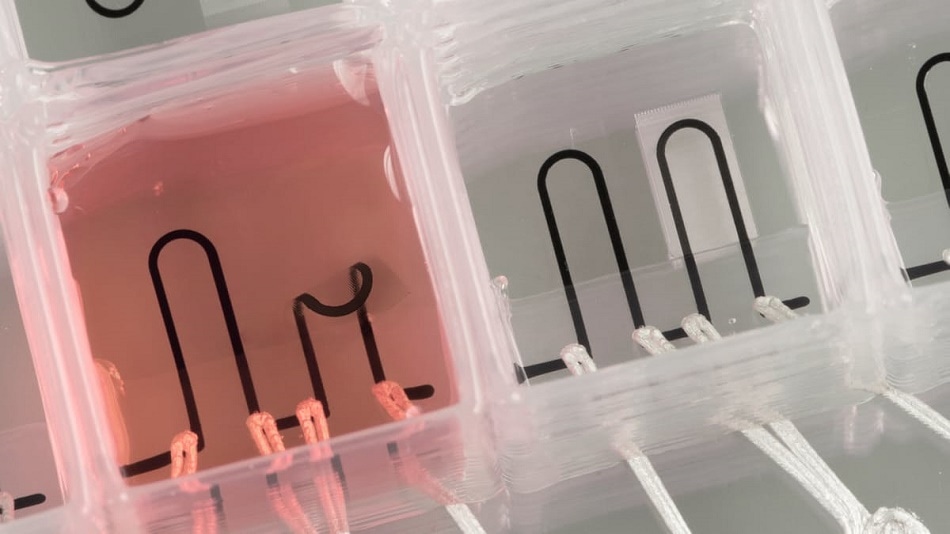Oct 25 2016
 The heart-on-a-chip is entirely 3-D printed with built-in sensors that measure the contractile strength of the tissue, providing scientists with new possibilities for studying the musculature of the heart. (CREDIT: Johan Lind, Disease Biophysics Group/Lori K. Sanders, Lewis Lab/Harvard University)
The heart-on-a-chip is entirely 3-D printed with built-in sensors that measure the contractile strength of the tissue, providing scientists with new possibilities for studying the musculature of the heart. (CREDIT: Johan Lind, Disease Biophysics Group/Lori K. Sanders, Lewis Lab/Harvard University)
Researchers from Harvard University have successfully built the first sensor-integrated completely 3D-printed organ-on-a-chip.
This 3D-printed heart-on-a-chip has been built using a digital manufacturing technique that is fully automated. Researchers can easily collect reliable data for short-term and long-term studies as it can be easily customized and fabricated.
This new manufacturing technique is expected to allow researchers to design organs-on-chips known as microphysiological systems, which can match the properties of an individual patient’s cells or even match a specific disease.
This work has been featured in the journal Nature Materials.
This new programmable approach to building organs-on-chips not only allows us to easily change and customize the design of the system by integrating sensing but also drastically simplifies data acquisition.
Johan Ulrik Lind, Postdoctoral Fellow, Harvard John A. Paulson School of Engineering and Applied Sciences (SEAS)
Lind is also a researcher at the Wyss Institute for Biologically Inspired Engineering at Harvard University.
“Our microfabrication approach opens new avenues for in vitro tissue engineering, toxicology and drug screening research,” said Kit Parker, Tarr Family Professor of Bioengineering and Applied Physics at SEAS, who coauthored the study. Parker is also a Core Faculty Member of the Wyss Institute.
Organs-on-chips imitate the function and structure of native tissue and are considered a potential alternative to traditional animal testing. Researchers at Harvard have now built microphysiological systems that replicate the functions and microarchitecture of intestines, tongues, hearts and lungs.
However, the data collection and fabrication process for organs-on-chips is laborious and costly. Currently, these devices are developed in clean rooms using a complicated, multi-step lithographic process, and the data collection process requires high-speed cameras or microscopy.
Our approach was to address these two challenges simultaneously via digital manufacturing. By developing new printable inks for multi-material 3D printing, we were able to automate the fabrication process while increasing the complexity of the devices.
Travis Busbee, Graduate Student, Harvard University
Six unique inks that had soft strain sensors integrated within micro-architecture of the tissue were developed by the researchers. In a single, continuous method, the researchers 3D printed those materials into a cardiac microphysiological device - a heart on a chip - with integrated sensors.
“We are pushing the boundaries of three-dimensional printing by developing and integrating multiple functional materials within printed devices,” said Jennifer Lewis, Hansjorg Wyss Professor of Biologically Inspired Engineering, and coauthor of the study. “This study is a powerful demonstration of how our platform can be used to create fully functional, instrumented chips for drug screening and disease modeling.”
Lewis is also a Core Faculty Member of the Wyss Institute.
Researchers can study many engineered cardiac tissues at a single time as the chip comprises of multiple wells, which each has separate integrated sensors and tissues. In order to present the efficacy of the device, researchers performed longer-term studies and drug studies of gradual changes in the contractile stress of engineered cardiac tissues, which can take place over the course of several weeks.
Researchers are often left working in the dark when it comes to gradual changes that occur during cardiac tissue development and maturation because there has been a lack of easy, non-invasive ways to measure the tissue functional performance. These integrated sensors allow researchers to continuously collect data while tissues mature and improve their contractility. Similarly, they will enable studies of gradual effects of chronic exposure to toxins.
Johan Ulrik Lind, Postdoctoral Fellow, Harvard John A. Paulson School of Engineering and Applied Sciences (SEAS)
“Translating microphysiological devices into truly valuable platforms for studying human health and disease requires that we address both data acquisition and manufacturing of our devices,” said Parker. “This work offers new potential solutions to both of these central challenges.”
The National Science Foundation, the National Center for Advancing Translational Sciences of the National Institutes of Health, the US Army Research Laboratory and the US Army Research, and the Harvard University Materials Research Science and Engineering Center (MRSEC) extended their support to this research.
3D-printed heart-on-a-chip with integrated sensors
Harvard John A. Paulson School of Engineering and Applied Sciences/Youtube.com